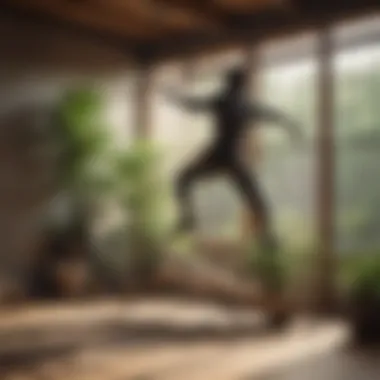The Art of the Ninja Flip Away: Techniques and Insights


Intro
In an era where agility serves as a metaphor for adaptability, the expression "ninja flip away" embodies both a physical maneuver and a psychological strategy. This article delves into the various facets of this dynamic movement, dissecting its historical roots, technical intricacies, and applications that extend beyond martial arts. Understanding the ninja flip away offers more than mere spectacle; it fosters a valuable skill set applicable to numerous aspects of life. The exploration aims to unveil not just how this technique is executed but also how it can enhance agility in modern contexts.
Key Insights and Trends
The ninja flip away has grown in cultural significance, transcending its traditional martial arts origins. This section examines current trends in agility training and movement sciences:
- Modern Agility Training: Agility training has evolved, incorporating techniques from various disciplines, including parkour and dance. The ninja flip away is increasingly adopted in fitness regimes for its ability to improve reflexes and coordination.
- Psychological Impact: Executing complex maneuvers like the ninja flip away requires mental resilience. Mental conditioning is as crucial as physical training, bolstering confidence and sharpness in high-pressure situations.
A growing curiosity about movements rooted in tradition invites individuals to experiment with their own physical capabilities. The ninja flip away symbolizes an intersection of heritage and innovation.
Technical Execution of the Ninja Flip Away
The execution of a ninja flip away demands precision and practice. To truly appreciate its intricacies, one must consider the following:
- Initial Stance: Begin in a balanced position. Keep your feet shoulder-width apart and your knees slightly bent.
- Preparation: As you prepare to flip, initiate a strong push-off with your legs. Engage your core to maintain stability.
- Execution: Rotate your body while pushing off the ground. Tuck your knees towards your chest to elevate yourself.
- Landing: As you come down, extend your legs for a smooth landing, ensuring to distribute the weight evenly to avoid injury.
Practicing this sequence consistently will build the coordination and strength required to successfully perform a ninja flip away.
Practical Applications Beyond Martial Arts
Understanding how the ninja flip away can be applied outside of martial arts highlights its versatility:
- Physical Conditioning: Enhanced agility can translate into various sports and activities, including dancing, gymnastics, and obstacle racing.
- Problem Solving: The quick-thinking skills cultivated during training can be redirected into everyday problem-solving scenarios. The mental fortitude gained is invaluable, teaching adaptability amidst challenges.
- Cultural Integration: As agility and reflexes become increasingly valued in modern lifestyles, programming that incorporates techniques from the ninja flip away can contribute to personal development and performance improvement across diverse activities and careers.
Ending
The ninja flip away is not merely a flashy display of athletic prowess. It embodies deeper functions of agility and adaptive movement in our daily lives. By exploring its origins, technical aspects, and broad applications, this guide aims to equip readers with the knowledge to incorporate these insights into their lives. It ultimately encourages a mindset geared towards adaptability and resilience, both in movement and thought.
Preamble to the Ninja Flip Away
The concept of the "ninja flip away" is not merely a display of acrobatics; it embodies a pinnacle of agility that can illuminate various aspects of physical performance. This article seeks to unravel its layers, illustrating its practical applications beyond the traditional martial arts realm. Delving into the significance of understanding the ninja flip away, we will cover its technical execution, historical origins, and the relationship it has with cultural expressions.
By analyzing this maneuver, one gains insights into flexibility, coordination, and timing. These are not just important for martial artists; they are critical skills applicable to disciplines such as athletics, dance, and even rehabilitation. Thus, the importance of this topic extends beyond a mere physical act. Understanding the ninja flip away enhances one’s holistic approach to movement.
Defining the Ninja Flip Away
The ninja flip away can be characterized as a rapid backward somersault executed to evade an attack or reposition in combat. It involves a coordination of limbs, proper spatial awareness, and mastery of body mechanics. While it may appear fantastical in film and fiction, the underlying principles of its execution hold substantial merit in real-world scenarios.
For practitioners, this movement is not only about physicality; it requires a deep comprehension of balance and body control. During the maneuver, the individual shifts their center of gravity in a way that maximizes agility while minimizing risk of injury. Each component, from a strong foundation to explosive power, contributes to the effectiveness of the ninja flip away.
Historical Context
Historically, the origins of the ninja flip away are rooted in the strategies of the ancient Japanese shinobi. These warriors relied on stealth and agility to accomplish their missions. The flip served a dual purpose: it allowed them to evade danger while maintaining an advantage against their opponents. Understanding the historical significance enriches our appreciation for the flip, revealing how techniques were crafted not merely for sport but for survival.
As Japan underwent cultural transformation, these methods were integrated into various forms of martial arts. The transition of the ninja flip away into competitive arenas showcases its adaptability and importance over the centuries.
Cultural Significance
Culturally, the ninja flip away has transcended its origins to become an emblem of agility and overcome adversity. In contemporary media, this maneuver symbolizes not only the skills of martial artists but also the broader themes of resilience and strategic thinking. It represents an ideal of adaptability—a quality that resonates in various spheres, from competitive sports to personal development.
The resonance of the ninja flip away is visible in films, literature, and even video games, shaping perceptions of agility. As a cultural artifact, it frames ideals surrounding heroism, skill, and the intricate relationship between mind and body. Understanding its significance can inspire individuals to embrace the agility it embodies, both physically and mentally.
Technical Analysis of the Ninja Flip Away
The technical analysis of the ninja flip away is crucial for understanding its complexity and execution. This analysis considers various elements that contribute to the success of the maneuver, including physical requirements, timing, and precision. Delving into these specifics not only enhances performance but also helps practitioners appreciate the underlying mechanics needed to execute this advanced technique effectively.
Anatomy of the Movement
The anatomy of the ninja flip away involves several key phases: take-off, rotation, and landing. Each phase demands specific muscle groups and coordination to ensure a fluid movement.


- Take-off: This initiates with a strong push from the legs. The practitioner bends their knees and shifts weight backward before launching off the ground. This action requires explosive strength and proper foot placement.
- Rotation: As the body leaves the ground, the individual must tuck in their legs and use their core muscles to rotate. Engaging the core helps maintain stability and control during the flip.
- Landing: Finally, as the practitioner descends, they need to extend their legs and prepare for impact. A controlled landing reduces the risk of injury and enhances overall safety.
Understanding these phases allows for proper training techniques and aids in pinpointing areas for improvement during practice sessions.
Biomechanics Involved
Biomechanics play a pivotal role in the execution of the ninja flip away. The human body functions in a mechanical way, and understanding these principles can lead to improved performance.
- Force Application: The act of taking off creates force. The force generated by the legs must overcome gravitational pull. This is where strength training becomes critical; stronger legs produce greater force for a more effective take-off.
- Angular Momentum: During rotation, the practitioner must manage angular momentum. This involves keeping the body in a tucked position to increase rotation speed. It is essential to have psychological awareness of body orientation.
- Joint Dynamics: Joints must work together symbiotically to produce seamless motion. Proper preparation and conditioning of the knees, ankles, and hips lead to better execution, stability, and less risk of injury.
These biomechanics underscore the need for both strength training and proper warm-up routines to prepare the body for high-impact maneuvers.
Common Techniques and Variations
Several techniques and variations exist within the realm of the ninja flip away, each offering different challenges and benefits.
- Backflip Variation: Focuses on backward rotation, primarily using core strength. It is often practiced by gymnasts and martial artists. This style enhances agility and provides unique advantages in combat scenarios.
- Side Flip: Involves lateral movement and requires different spatial awareness compared to traditional flips. It benefits agility and body control.
- 360 Flip: A more advanced version where the practitioner rotates both horizontally and vertically. This requires intricate timing and exceptional balance.
Practicing these techniques offers variety and caters to the specific physical attributes and preferences of the individual, promoting a well-rounded skill set.
"Understanding the technical aspects of the ninja flip away is paramount for mastering it efficiently. Every element from strength to mechanics must be well-aligned to achieve success."
Psychological Aspects of Agility
Understanding the psychological components of agility plays a crucial role in mastering the ninja flip away. These elements include how individuals manage their fears, maintain focus, and access optimal performance states. Successful execution of complex movements, such as the ninja flip away, requires not just physical skill but also a strong mental framework. This section delves into the various psychological aspects that can enhance agility, allowing practitioners to perform with confidence and precision.
Fear and Risk Management
In any physical discipline, fear can serve as both a barrier and a motivator. For those looking to master the ninja flip away, understanding fear is essential. It may arise from the dangers associated with heights, falls, or perceived inadequacies in skills. This anxiety can freeze action or, conversely, propel one into a focused state of readiness.
Managing fear involves techniques like visualization, which prepares the mind for upcoming challenges. Visualization refers to mentally rehearsing the movement before performing it physically. This practice can reduce anxiety and clarify the steps involved in executing the ninja flip away successfully. Additionally, risk assessment becomes important. Understanding the actual dangers in various environments allows for informed decisions about when or how to perform this maneuver. Some strategies include:
- Gradual exposure to challenging situations.
- Practicing in a safe environment to build confidence.
- Setting realistic milestones to track progress.
Through effective fear management strategies, an individual can turn potential barriers into tools for growth, ultimately enhancing agility and execution.
Focus and Mental Conditioning
Concentration is key when athletes or martial artists perform complex movements. Maintaining focus can be challenging, especially in dynamic or high-pressure environments. Mental conditioning practices, such as mindfulness and meditation, help improve concentration. These methods train the brain to maintain focus amid distractions.
In addition, developing a pre-performance routine can further enhance mental conditioning. This routine may include:
- Deep breathing exercises to calm nerves.
- Specific warm-up movements to engage the body.
- Positive affirmations to boost self-confidence.
By implementing these practices, practitioners prepare themselves mentally and physically, which can lead to improved performance when executing the ninja flip away.
Flow State and Performance
The concept of flow state refers to being fully immersed in an activity, where actions feel effortless and time seems to disappear. Achieving flow is often linked with peak performance. It encourages an experience of fluidity and instinctual movement, which is vital for executing a ninja flip away smoothly.
To cultivate a flow state, individuals should:
- Set clear goals that challenge their current abilities without overwhelming fear.
- Eliminate distractions to maintain focus on the task at hand.
- Enter a practice or competitive situation with an adaptive mindset, staying open to experiences as they unfold.
Practicing these strategies not only aids in achieving flow but also reinforces physical skills and mental resilience. In turn, this enhances the overall agility necessary for efficient execution of complex movements like the ninja flip away.
Physical Conditioning for Mastery
Physical conditioning is vital for executing the ninja flip away effectively and safely. Mastering this maneuver requires not just inherent skill, but also a robust physical foundation that enhances strength, flexibility, and endurance. Each component of physical conditioning plays a specific role in developing the capabilities necessary for this complex movement. Focusing on improving these elements can profoundly affect performance and reduce the risk of injury.
Strength Training Regimens


Strength training forms the backbone of physical conditioning for mastering the ninja flip away. The key muscle groups involved include the legs, core, and upper body. Exercises such as squats, deadlifts, and box jumps increase explosive power.
- Leg strength: Critical for jumping high and landing softly.
- Core stability: Engaging the core helps in maintaining balance during the flip.
- Upper body strength: Important for the initial push-off and control during the aerial phase.
Implementing a progressive strength training program not only builds muscle but also improves functional movement patterns, essential for fluid execution. Incorporating compound movements alongside agility drills can yield significant improvements in both strength and tactical timing.
Flexibility and Mobility Work
Flexibility and mobility play a crucial role in the ninja flip away. They enable a broader range of motion in joints and muscles, which is necessary for fluid movement during the technique. Without sufficient flexibility, one risks injury during high-intensity maneuvers.
A well-rounded flexibility program may include:
- Dynamic stretching: Before training, to prepare muscles.
- Static stretching: After workouts, to enhance recovery.
- Foam rolling: To improve muscle elasticity and reduce soreness.
Achieving higher flexibility in the hips, shoulders, and back can lead to better execution of the flip and aid in quicker recovery after strenuous workouts.
Endurance and Stamina Building
Endurance is an often overlooked yet critical component of mastering physical skills like the ninja flip away. Increased stamina allows an individual to perform high-intensity movements over extended periods. Cardiovascular conditioning supports this aspect.
Effective endurance training could involve:
- Interval training: Short bursts of high intensity followed by rest.
- Circuit training: Engaging in various exercises in sequence with minimal rest.
- Long runs or cycling sessions: Enhances cardiovascular health.
By merging endurance with power and flexibility training, practitioners create a more rounded athlete. This helps in maintaining form and energy levels throughout an exhausting workout or performance.
Improving physical conditioning is not merely about strength, flexibility, or endurance alone. It is about creating a harmonious blend of these elements to achieve mastery in agility and execution.
Applications Beyond Martial Arts
The concept of the ninja flip away extends far beyond the domain of martial arts. While its origins stem from ancient practices of stealth, agility, and combat techniques, its applications are now being recognized in various fields. Understanding its relevance outside of martial arts reveals new pathways for training, movement efficiency, and even artistic expressions. This section explores three key areas where the principles of the ninja flip away can be effectively applied, highlighting their benefits and implications.
In Sports and Athletics
Athletes in numerous sports are constantly seeking an edge in performance. The ninja flip away offers essential insights into agility and body control. For instance, gymnasts can incorporate elements of this movement to enhance their routines during floor exercises. Similarly, basketball players can utilize these principles for quicker directional changes, improving their overall speed and court agility.
Key benefits of the ninja flip away in sports include:
- Enhanced Agility: The techniques involved improve the athlete's ability to maneuver quickly and efficiently, reducing reaction time.
- Injury Prevention: Proper execution of these flips emphasizes body alignment and control, helping to lower the risk of common sports injuries.
- Versatility: Skills developed from practicing the flip can transfer to multiple sports disciplines, making it a valuable addition to any athlete’s training regimen.
In Dance and Performing Arts
In dance, the ninja flip away embodies grace, fluidity, and control. Choreographers and dancers can integrate movements inspired by this technique to craft more dynamic performances. Styles such as contemporary and hip-hop can particularly benefit from the incorporation of the ninja flip away, allowing artists to express creativity while maintaining technical precision.
Some considerations for dance include:
- Choreographic Innovation: The flip can introduce novel movement patterns, inspiring new routines that capture audience attention.
- Physical Demand: Dancers experiences physical strain when executing these movements. Training for strength and flexibility is critical to perform safely.
In Physical Therapy and Rehabilitation
The principles behind the ninja flip away can also be applied in physical therapy settings. Therapists can use movements resembling the flip for rehabilitation plans tailored to patients recovering from injuries. Achieving graceful movement can help rebuild confidence while increasing mobility.
Benefits of this application include:
- Functional Recovery: Exercises inspired by the ninja flip can enhance the functionality of daily movements, aiding patients to regain normalcy.
- Focus on Mobility: Emphasizing agility through low-impact adaptations can improve overall movement patterns, crucial for various rehabilitation scenarios.
“Agility training derived from skills like the ninja flip offers a productive method for improving recovery and enhancing overall physical coordination.”
Ninja Flip Away in Popular Culture
The ninja flip away has become a captivating symbol in popular culture. This phenomenon transcends mere physical movement; it symbolizes agility, stealth, and quick thinking. In films, video games, and merchandising, this maneuver highlights not just skill, but also the cultural fascination with ninjas and their lore. The representation of the ninja flip away serves as a bridge between traditional martial arts and modern reinterpretations, showcasing its relevance in contemporary society.


Film and Television Representations
Films and television shows have played a significant role in popularizing the ninja flip away. From classic movies featuring martial arts to modern action films, these flips are often depicted as a climactic moment. They not only showcase the physical skill of the characters but also elevate the stakes of the narrative. Iconic films such as "The Last Samurai" or series like "Ninja Assassin" portray our protagonists using these acrobatic moves as a means of escape or tactical advantage. Such portrayals enhance the viewer's perception of ninjas as highly skilled warriors, effectively cementing the flip away in our collective consciousness.
Using the ninja flip away as both a narrative device and a display of skill creates a lasting impression on the audience, encouraging them to view martial arts as more than physical combat. Instead, it emphasizes the mental agility and quick decision-making involved in executing such moves.
Video Games and Interactive Media
Video games have also embraced the concept of the ninja flip away. Titles like "Tenchu: Stealth Assassins" or "Ninja Gaiden" allow players to engage in acrobatic maneuvers, making the flip a fundamental part of gameplay. Here, agility is not only a matter of aesthetics but a critical element for success. Players must master these movements to avoid enemies, complete missions, or solve puzzles.
Furthermore, the representation of the ninja flip away in these games caters to a sense of empowerment. Players feel a sense of accomplishment as they learn to harness these skills, which resonate with the fantasy of becoming a stealthy warrior. This engagement reveals how the flip away is integrated into the gaming narrative, enhancing both player experience and game popularity.
Merchandising and Branding Impact
The ninja flip away has also influenced merchandising and branding. From action figures to apparel, the image of a ninja performing this maneuver is widely recognized. Companies capitalize on this symbolism, portraying their products as embodying agility and stealth.
In the realm of martial arts gear, brands like Century Martial Arts use the appeal of ninja aesthetics to market their products effectively. This not only promotes their offerings but also perpetuates the cultural fascination with the concepts associated with ninjas.
"The ninja flip away is not just a movement; it is an emblem of agility, representing the intersection of skill, culture, and entertainment."
In summary, the ninja flip away has permeated various aspects of popular culture. Through films, video games, and merchandise, it embodies the qualities of agility, stealth, and quick thinking, resonating with diverse audiences. It is crucial to recognize the impact of this maneuver beyond its physical execution, as it contributes to the broader cultural dialogue surrounding martial arts and physical agility in our daily lives.
Philosophy of Movement
The philosophy of movement serves as a foundational pillar for understanding the ninja flip away. This concept blends the physical and mental aspects of agility. Emphasizing movement not just as a physical act, it also delves into the mindset that complements the execution of such maneuvers. The benefits of this philosophy extend beyond mere performance. It enhances mindfulness, which can translate into improved decision-making in real-life scenarios.
The study of movement encourages practitioners to connect with their bodies in a deeper sense. This connection can lead to greater awareness of one's capabilities and limitations. Hence, understanding this philosophy provides significant insights into the nuances of performance and agility.
The Concept of Flow in Movement
Flow is a state of optimal experience, characterized by complete absorption in an activity. In the context of the ninja flip away, achieving flow means that the performer is fully immersed in the act. There are few distractions. Such focus is crucial for executing complex movements with precision.
Adopting the flow concept can lead to smoother transitions during various maneuvers. Practitioners often describe this state as effortless, where movements seem to happen organically. Several techniques can be employed to facilitate entering this flow state:
- Practice and Repetition: Consistent practice allows for muscle memory to develop.
- Mindfulness Techniques: Engaging in activities that promote mindfulness helps maintain focus on the present moment.
- Setting Goals: Establishing clear objectives can guide the practitioner towards entering a flow state effectively.
Harmony Between Mind and Body
Achieving harmony between the mind and body is crucial for executing the ninja flip away effectively. When the mind is in sync with the physical body, the result is more fluid and graceful movement. This harmony allows the individual to respond instinctively to changing circumstances during performance.
Considerations in promoting this harmony include:
- Breath Control: Regulating breathing can help center thoughts and enhance focus during performance.
- Visualization: Imagining the steps of the movement can aid in preparing both mind and body before execution.
- Physical Conditioning: A well-conditioned body enhances confidence in performing complex moves, which in turn promotes mental clarity.
"The true mastery of movement lies not only in the physical execution but also in the mental poise that accompanies it."
Engaging in this philosophy of movement leads to improved performance in the ninja flip away and contributes to overall well-being. By understanding how movement, thought, and breath interact, practitioners can enhance not only their agility but also their everyday problem-solving skills.
Finale
The exploration of the ninja flip away encapsulates a rich interplay of agility, technique, and psychological factors. In this article, we have dissected various components that contribute to mastering this impressive maneuver. Key insights reveal the importance of physical conditioning, mental preparation, and cultural significance.
Summarizing Key Insights
The examination of the ninja flip away has highlighted several critical aspects:
- Historical Relevance: Understanding the origins of the ninja flip away sheds light on traditional practices that enhance modern interpretations.
- Technical Proficiency: Mastery of the movement involves analyzing the biomechanics and execution, ensuring proper technique to prevent injuries.
- Psychological Readiness: Performance is not solely about physical prowess; mental conditioning also plays a crucial role in executing the flip effectively.
- Cross-Disciplinary Applications: The techniques discussed find relevance in various fields beyond martial arts, including dance, sports, and even rehabilitation, making the knowledge broader and applicable.
"The agility training not only boosts physical skills but also enhances cognitive function, allowing for better problem-solving abilities in everyday situations."
Future Implications of Agility Training
Agility training, particularly through movements like the ninja flip away, carries significant promise for future applications, such as:
- Increased Demand for Diverse Training Regimens: As agility becomes recognized as a critical component of overall fitness, there is likely to be a rise in specific training programs designed to enhance this skill.
- Expansion into New Domains: We can anticipate the incorporation of elements from agility training into fitness classes, rehabilitation programs, and athletic training.
- Integration of Technology: Tools and platforms for performance tracking may become more advanced, providing detailed feedback on agility-based techniques, fostering innovation in training methods.
The comprehensive understanding of agility from the perspective of the ninja flip away not only enhances physical capability but also offers a compelling framework for cognitive and cultural engagement, emphasizing its relevance across multiple dimensions.



